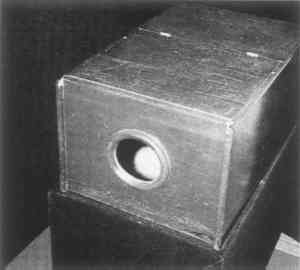A CONSERVATION CASE STUDY OF POLYRAMA PANOPTIQUE PAPER VIEWING SLIDESTED STANLEY
2 THE COLLECTIONThis paper concerns the conservation of a Polyrama Panoptique in the Graphic Arts Collection of the Princeton University Library. The Polyrama Panoptique was acquired in 1993 from a local rare books dealer who had purchased it from a family in New Jersey. The paper viewing slides in the collection were in such terrible condition that most of them could not be used. Numerous treatment strategies for restoring the slides to usable condition were evaluated, and two treatment approaches were implemented. 2.1 DESCRIPTIONThe 24 viewing slides in the Princeton University Library's Polyrama Panoptique are hand-colored lithographs attached to wooden strainers. Most depict scenes of Paris, France, and its environs. There are also scenes of other European cities, and from the United States, a view of Barnum's Museum in Philadelphia. Manuscript labels are sometimes found on the backs of strainers. The labels, written in French, contain the titles of the slides. White chalk occasionally records the title of a slide in English on the back of the strainer when the manuscript label is absent. The names of the artists or dates are nowhere on the slides. The wooden strainers of the slides measure 24 cm wide � 19 cm high and are made of four pieces. Each piece of wood measures 1.7 cm wide � .7 cm thick. A “channel groove” join attaches the four parts together (fig. 3). An adhesive is used in the joins along with occasional
Samples were taken of the strainer's wood and the paper supports to identify them. An examination of a fiber sample of the wooden strainer was carried out using an Olympus BH-2 polarized light microscope. Vessel elements of the fiber sample are clearly visible at 200x magnification. The presence of vessel elements indicates that the sample is hardwood, and the morphology of the fiber appears to indicate that it is European Poplar (Core 1979). Graff's “C” stain spot testing and microscopic examination at 100x using the polarized light microscope revealed that the primary and secondary sheets of wove paper appeared to be composed of flax and cotton. Ninhydrin spot testing of the adhesive that attaches the supports to the strainer indicated the presence of a protein glue. The show box is constructed of stained and varnished mahogany wood (fig. 4). It has an 8 cm diameter convex glass lens at the front of the box in which a single viewer can peep into the box. The box measures 29 cm wide � 21.5 cm high � 44.5 cm in diameter. A hinged lid, which the viewer opens and closes, is attached at the top rear of the box. The rear door of the show box is missing. A vertical slot in which a viewing slide is placed is located in back of the box. The show box can be taken apart easily and therefore has the advantage of being portable.
2.2 CONDITIONBefore conservation, most slides were totally unusable. In addition to huge losses and tears in the supports, past repairs themselves introduced damage. Deteriorated and stained glassine paper patches were in many instances adhered to the rectos and versos of the primary and secondary supports. Surface dirt and layers of dust were present as well. The pigments, however, were in good condition, and the hand-colored watercolor was still bright and vibrant. Overall, little damage to the wooden strainers was found. With the exception of the missing rear door and scratches on its outer surface, the show box was also in good condition. |

